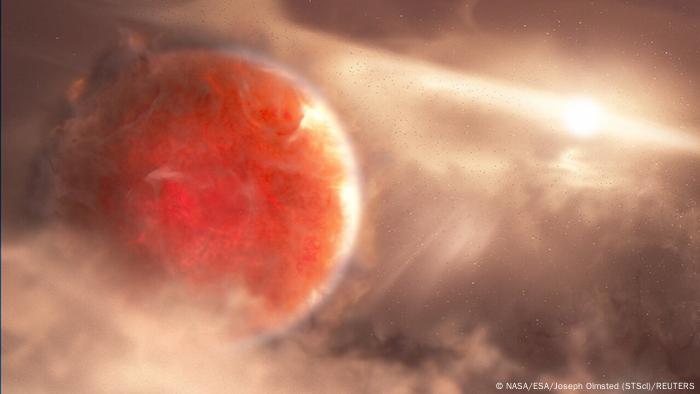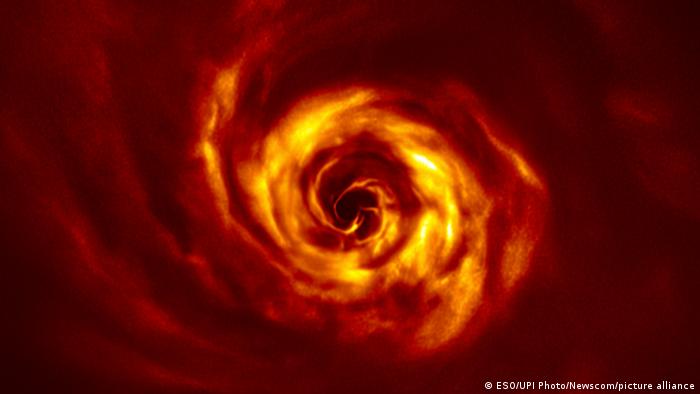Planet AB Aurigae b is still in its "birthing" stages. But astronomists say it is already nine times the mass of Jupiter and it's forming in a unusual way.

An illustration of AB Aurigae b, a giant gas planet discovered with the help of the Subaru Telescope and Hubble Space Telescope
AB Aurigae b is still only a baby as far as planets go. It's a giant gas planet that scientists have discovered in the early stages of its formation. And it's already breaking records in astronomy. Astronomers say the planet is nine times the mass of Jupiter — and that it is challenging our understanding of how planets form.
Jupiter is our solar system's largest planet. It has a mass that's almost 320 times that of Earth and more than two-and-a-half times that of all the other planets in our solar system combined. It is, in other words, pretty darn heavy.
But AB Aurigae b makes Jupiter look like a little balloon.
"We think it is still very early on in its 'birthing' process," astrophysicist Thayne Currie of the Subaru Telescope and the NASA Ames Research Center told news agency Reuters.
Currie is the lead author of a study on the planet's discovery that has been published in the journal Nature Astronomy.
"Evidence suggests that this is the earliest stage of formation ever observed for a gas giant," said Currie.
Gas giants have a small solid core. But they are mostly made up of gasses — hydrogen and helium — that swirl around that core.
Our solar system has two gas giants: Jupiter and Saturn. The Earth and Mars, for comparison, are known as rocky planets.
A planet with a massive host star
Researchers detected the new gas giant with the help of two telescopes — one on the ground and one orbiting Earth.
The Subaru telescope is located near the summit of an inactive Hawaiian volcano and the Hubble Space Telescope is in a low-Earth orbit.
As the scientists would have expected, AB Aurigae b has a star. When planets form they tend to have a host star. Planets orbit stars. And in this case, the star is called AB Aurigae.
It is itself a very young star. AB Aurigae is only about 2 million years old, whereas our sun (also a star) is roughly 4.5 billion years old.

A disc surrounds a newly discovered planet's host star, AB Aurigae
The planet is embedded in an expansive disk of gas and dust. Planets form from the materials in these disks, with small objects like grain and rocks swirling around, colliding and sticking together.
All that is quite normal. But there is something unusual about the planet and its star.
A planet and star far apart
The planet and its star seem to be far too far apart for any of those swirling bits to stick and form the planet.
AB Aurigae b is three times as far away from its star as Neptune is from our star, the sun. That's three times the distance that astronomers normally observe.
"This process cannot form giant planets at large orbital distance, so this discovery challenges our understanding of planet formation," Olivier Guyon, an astronomer at the Subaru telescope and the University of Arizona, told Reuters.
The researchers believe that the planet may have formed when the disc around its host star cooled and gravity caused it to fragment into one or more clumps ― one of which turned into the planet.
"There's more than one way to cook an egg," Currie said. "And apparently there may be more than one way to form a Jupiter-like planet."
Edited by: Zulfikar Abbany

EARTH-LIKE PLANETS AND OTHER CELESTIAL DISCOVERIES
Another planet Earth?
The European Southern Observatory (ESO) has discovered a third Earth-like planet orbiting the star Proxima Centauri, the closest star to our sun at four light years away. A planet is considered Earth-like if scientists suspect it provides conditions that could make life theoretically conceivable, such as a certain temperature range, gravity, an atmosphere and the possibility of water.
12345678910111213
No comments:
Post a Comment